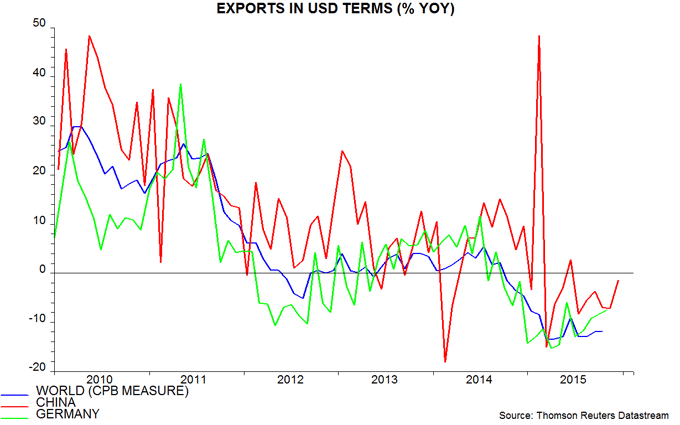Chinese exports better, market share still rising
Chinese December trade flows were significantly less weak than expected, although monthly data are volatile. Exports, in particular, fell by only 1.4% in US dollar terms from a year before – the smallest annual decline since June.
The results suggest that Chinese exporters continued to gain market share at year-end, casting doubt on claims that the exchange rate was or remains overvalued. The dollar value of world trade fell by 11.9% in the year to October, according to the Dutch CPB institute, a month in which the annual decline in Chinese exports was “only” 6.9% – see chart. Few countries have yet released December data: the Chinese export result was far better than a 13.8% annual fall in Korea.
There is concern that the Chinese numbers have been distorted by fake invoicing associated with illegal capital outflows. This could partly explain stronger-than-expected imports but is unlikely to have affected the export data – overrecording of exports typically occurs when companies wish to bring capital onshore in expectation of a rising yuan, not vice versa.
In other Chinese news, auto production rose by an annual 16.0% in December following a 17.7% gain in November. This suggests that the larger contribution of the auto sector to annual industrial output growth in November will be sustained in December results next week.
A recent supposedly-bearish story was that rail freight volume fell by 10.5% in calendar 2015. If confirmed by official data, this actually suggests a slowdown in the rate of decline at year-end. More importantly, rail freight is no longer (if it ever was) a useful coincident indicator of economic activity because of structural change and a shift to road, which carries nearly 10 times as much volume. Road freight volume rose by 7.4% in the year to November, with total freight up by 5.4%. The declining share of rail implies that the widely-quoted “Li Keqiang index" – which combines changes in rail freight volume, electricity consumption and bank loans – seriously understates economic growth.


Reader Comments